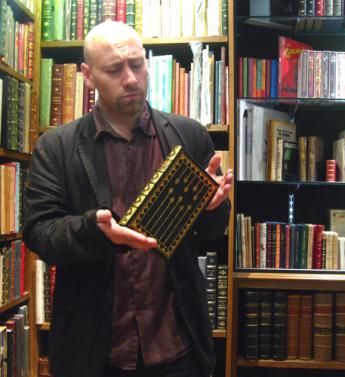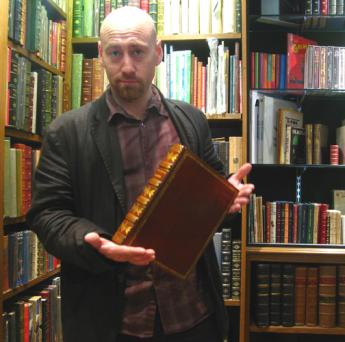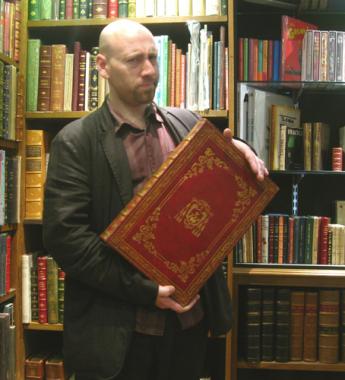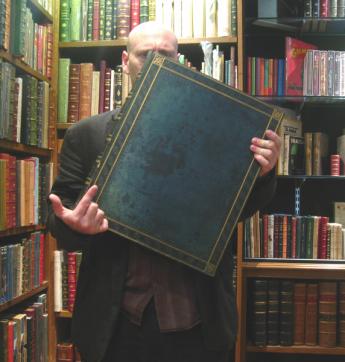Tip Antiquarian Booksellers' Association Adrian Harrington Rare Books
Book Sizes and Taking Advantage of Bald Men

By Bibliodeviant
Book Sizes, also known as a book’s format, at first sight come across as a bit pointlessly arcane:
Folio: Fo. or 2° (try and imagine the 2 as really big and the O as really small)
Quarto: Qto. or 4to or even 4°
Octavo: Oct. or 8vo
Duodecimo: 12mo (usually spoken as twelvemo)
Sextodecimo: 16mo (sixteenmo)
Vicesimo-quarto: 24mo (twentyfourmo)
Tricesimo-secundo: 32mo (thirtytwomo)
They are the most commonly used. There are a myriad of variations within each theme “Crown Octavo”, “Elephant Folio” , “Royal Quarto”, “Small..”, “Squat..” etc. These are usually tied to bibliographical descriptions from SOMEONE OLD AND DISTINGUISHED tm. who wrote about this book eighty years ago and whose word has been taken ever since. (Bibliography based ranting will follow on another day).
You might wonder why we can’t just say “It’s nine inches or so.” (generally when you hear this, it’s a lie), and indeed there is a gradual modern book cataloguing trend towards just giving an imperial or metric measurement. This is fine, it’s a bit sad, but it’s fine.
I tend to think that most old books were “designed” with a specific impression in mind (even if the motivator was merely avarice), and if it was designed as a Royal Octavo, then that is how it should be described, even if you then add the rider “7 inches by 6 and a half”.
Still that’s just me, at Adrian Harrington Rare Books we use a subtle and mystifying blend of classic terms, inches, centimetres and the occasional cubit depending on how obtuse we’re feeling. In order to illustrate relative book sizes we have enlisted the assistance of an average sized human to give a sense of scale:
(See the pictures above right)
Our glamorous assistant (come on, have you seen the state of the economy?), is holding a calf half-bound 16mo (sextodecimo) volume. As you can see it is having no effect on the glamorousness at all. This was a particularly common eighteenth century format (not exclusively! Calm down) as the increase in readily available and efficient transport made reading whilst post-chaising to Brighton a possibility rather than an exercise in endurance and courage.
In this glorious example of the photographic art (behind the shades of Robert Capa and Henri Cartier Bresson howling in rage) you will see that the odd bald man is holding a 12mo (duodecimo) volume. This (amongst many other examples) would be the general size of a Jane Austen first edition for example.
Here we have an example of the most common book size: the fabled Octavo (8v0). It has always been the most handy format for books, probably 8 out of 10 books in this shop are octavo in one flavour or another, as are airport paperbacks, standard modern hardbacks and frequently everything else from Conan Doyle to Shakespeare.
Next up is the quarto (4to), somewhat larger and heavier than the octavo, for a variety of reasons this size is beloved of eighteenth and nineteenth century creators of travel books; everything from Cook’s Voyages to Franklin’s Journey to the Polar Seas can be found in this size. The book being held by the scary man is in fact John Barrow’s copy of the Travels of Marco Polo, thus adding weight to my somewhat tenuous point. The quarto is beloved of people who want to produce books full of elaborate folding maps and charts. And God books. frequently seen in quarto is God.
Large folio (Lg Fo, etc.). Large, impressive, suitably difficult to shelve. A nightmare to ship, but excellent for hiding unsightly bookdealers behind.
That’s a very quick run down of the more commonly catalogued sizes, just as a quick reference. Should you wish to obtain your own bald man to use as a sizing guide he is available for hire and will accompany you to various bookshops and hold books for your delectation and education. For a small fee.
The article was posted on Bibliodeviancy, the blog of Adrian Harrington Rare Books. It is presented here by permission of the author.




